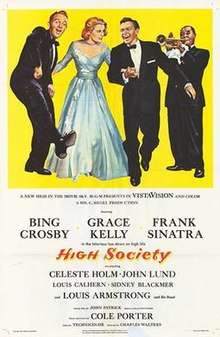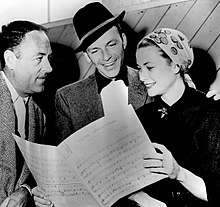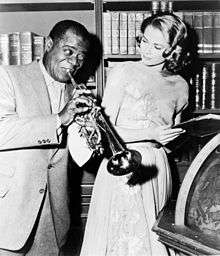High Society (1956 film)
High Society is a 1956 American romantic musical comedy film directed by Charles Walters and starring Bing Crosby, Grace Kelly, and Frank Sinatra. The film was produced by Sol C. Siegel for Metro-Goldwyn-Mayer, and shot in VistaVision and Technicolor, with music and lyrics by Cole Porter.
| High Society | |
|---|---|
 Theatrical release poster | |
| Directed by | Charles Walters |
| Produced by | Sol C. Siegel |
| Screenplay by | John Patrick |
| Based on | The Philadelphia Story 1939 play by Philip Barry |
| Starring | |
| Music by | Cole Porter |
| Cinematography | Paul Vogel |
| Edited by | Ralph E. Winters |
Production companies |
|
| Distributed by | Metro-Goldwyn-Mayer |
Release date |
|
Running time | 111 minutes |
| Country | United States |
| Language | English |
| Budget | $2.7 million[1] |
| Box office | $8.2 million[1] |
The film is a musical remake of the 1940 film The Philadelphia Story starring Cary Grant, Katharine Hepburn, and James Stewart, which was based on the 1939 play The Philadelphia Story by Philip Barry (which had starred Hepburn on Broadway). High Society's screenplay was written by John Patrick and involves a successful popular jazz musician (Crosby) who tries to win back the affections of his ex-wife (Kelly), who is preparing to marry another man. The cast also features Celeste Holm, John Lund and Louis Calhern, in his final film, with a musical contribution by Louis Armstrong.
High Society was Kelly's last film appearance, before she became Princess consort of Monaco.
Plot
Successful jazz musician C.K. Dexter Haven (with a Newport "robber baron for a grandfather") is divorced from wealthy Newport, Rhode Island, socialite Tracy Samantha Lord, but remains in love with her. She, however, is about to marry a bland gentleman of good standing, George Kittredge.
Spy Magazine, a fictional tabloid newspaper in possession of embarrassing information about Tracy's father, sends reporter Mike Connor and photographer Liz Imbrie to cover the nuptials. Tracy begins an elaborate charade as a private means of revenge, introducing her Uncle Willy as her proper father Seth Lord and the latter as her "wicked" Uncle Willy.
Connor falls in love with Tracy, who must choose among three very different men in a course of self-discovery. After becoming tipsy at a party on the eve of her wedding and going off with Connor for a romantic swim, Tracy decides to go through with it until Kittredge takes umbrage. While in the process of telling her guests that the wedding is off, Tracy is surprised by a proposal from Dexter to take the groom's place. Realizing where her heart truly is, she accepts.
Cast
- Bing Crosby as C. K. Dexter Haven
- Grace Kelly as Tracy Samantha Lord
- Frank Sinatra as Macaulay "Mike" Connor
- Celeste Holm as Liz Imbrie
- John Lund as George Kittredge
- Louis Calhern as Uncle Willie
- Sidney Blackmer as Seth Lord
- Louis Armstrong and His Band as themselves
- Edmond Hall – Clarinetist
- Trummy Young – Trombonist
- Billy Kyle – Pianist
- Arvell Shaw – Bassist
- Barrett Deems – Drummer
- Margalo Gillmore as Mrs. Seth Lord
- Lydia Reed as Caroline Lord
- Gordon Richards as Dexter Haven's butler
- Richard Garrick as Lords' butler
- Philo McCullough as Party Guest (uncredited)
Production

Filming took place between January and March 1956. The film was shot mostly in and around Clarendon Court in Newport, Rhode Island, which was then owned by Mae Cadwell Hayward,[2] and later purchased in 1970 by Claus von Bulow.[3]
The location, according to Turner Classic Movies, enabled them to take advantage of the Newport Jazz Festival, established in 1954, incorporating it into the film by giving Crosby's character a background as a descendant of a Gilded Age robber baron who became a jazz composer and friend of jazz star Louis Armstrong, who plays himself in the film, and patron of the Festival.[4] As name-checked by Crosby in the song "Now You Has Jazz", where each musician takes a small solo, Armstrong's band includes: Edmond Hall (clarinet), Trummy Young (trombone), Billy Kyle (piano), Arvell Shaw (bass), and Barrett Deems (drums).
This film featured Kelly's final role before she became Princess of Monaco; it was released three months after her marriage to Prince Rainier III. In the film, Kelly wore the Cartier engagement ring given to her by Rainier.[5] Sinatra was 40 and Crosby 53 while playing the love interests of Kelly, who was only 26 during the filming. Sinatra biographers George Jacobs and William Stadiem make the claim that Crosby kept his distance from Sinatra during the production and remained strictly professional when Sinatra desired companionship, and that it "killed" Sinatra to think that Crosby considered himself a higher class singer. However this is rejected by TCM, which states that "in spite of a rumored rivalry between Frank Sinatra and Bing Crosby, the two worked together very amicably during the shoot."[4]
They claim that Sinatra was fascinated with Grace Kelly – as were many of her previous co-stars – and would have loved to have an affair with her but feared rejection and embarrassment in front of Crosby, who had previously had an affair with Kelly.[6]
The sailboat used in the film, the True Love (originally the Venona II based on the Malabar design by John Alden built for racing), sails on Seneca Lake out of Watkins Glen, NY as an excursion boat for Schooner Excursions, Inc.[7]
Musical numbers

Producer Sol C. Siegel paid Porter $250,000 for his first original film score in eight years;[8] it introduced a couple of pop standards, including "True Love" and "You're Sensational". Not only did Sinatra and Crosby collaborate for the first time,[8][9] but behind the scenes two master orchestrators – Conrad Salinger and Nelson Riddle – melded their arrangements under the baton of Johnny Green. Armstrong and his band get a couple of standout moments and Kelly has her only role in a musical.
- "Overture"
- "High Society Calypso" – Armstrong & his band
- "Little One" – C.K.
- "Who Wants to Be a Millionaire?" – Mike, Liz
- "True Love" – C.K., Tracy
- "You're Sensational" – Mike
- "I Love You, Samantha" – C.K.
- "Now You Has Jazz" – C.K., Armstrong & his band, individually introduced by name
- "Well, Did You Evah!" – C.K., Mike[9][10]
- "Mind if I Make Love to You?" – Mike
A soundtrack album was released the year of the film's release and was a major success in both America and the United Kingdom. It has been said that one of the main reasons star Sinatra was drawn to the film was a mock-tipsy duet with his boyhood idol Crosby on "Well, Did You Evah!", a song from an earlier Porter show, DuBarry Was a Lady (1939), re-adapted and added at the last minute when it was noted that the two singers did not have a duet to perform in the film.
The title of the song "Who Wants to Be a Millionaire?" gained new significance a half-century later as the title of a global game show franchise. "I Love You, Samantha" has also become a jazz favorite for improvisations.
When Bing Crosby sang "Now You Has Jazz", he uttered the Porter lyric "rock and roll", and it very well might have been the first time that phrase was uttered on film. It would have been ironic coming from Crosby since rock and roll would very soon eclipse the jazz and swing of Crosby, Sinatra, and Armstrong. The first rock and roll film came out the following year.
Release
Critical reception
Opening on July 17, 1956, High Society garnered mixed reviews, often being compared as a lesser offering to The Philadelphia Story, a previous adaptation in 1940 of the same play starring Cary Grant in the Crosby part, Katharine Hepburn in the Kelly role, and James Stewart in an Oscar-winning turn as the reporter played in the remake by Sinatra. Variety noted: "High Society should spell high finance business all over. It's a solid entertainment every minute of its footage. Fortified with a strong Cole Porter score, film is a pleasant romp for cast toppers Bing Crosby, Grace Kelly and Frank Sinatra who, tactfully, get alphabetical top billing. Their impact is almost equally consistent. Although Sinatra has the top pop tune opportunities, the Crooner makes his specialties stand up and out on showmanship and delivery, and Miss Kelly impresses as the femme lead with pleasantly comedienne overtones. This is perhaps her most relaxed performance ..."[11]
Bosley Crowther of The New York Times described it as "flimsy as a gossip-columnist's word", missing "the snap and the crackle that its un-musical predecessor had."[12] According to Time, in spite of its "Who's Who cast" the film is "simply not top-drawer"; a "good deal of the screenplay seems as dated today as the idle rich ... [Kelly] lacks the gawky animal energy that Katharine Hepburn brought to the 1939 play and the 1941 movie, [Crosby] saunters through the part rather sleepily, without much of the old Bing zing [, and] Sinatra plays the reporter like a dead-end kid with a typewriter."[8]
Box office
At the North American box office, High Society was a success. It was one of the 10 highest grossing films of 1956 in the US and Canada earning $5,602,000, and $2,656,000 elsewhere, resulting in a profit of $1,148,000.[1]
Awards & Nominations
High Society received two Academy Award nominations, and nearly received a third. The film was initially nominated in the 1956 Academy Awards for Best Motion Picture Story, even though it was based on the 1940 film The Philadelphia Story and thus was not eligible in that category. Moreover, the nominated writers, Elwood Ullman and Edward Bernds, had written not this film, but a 1955 Bowery Boys film also titled High Society.
According to the book Inside Oscar, Steve Broidy, president of The Bowery Boys home studio Allied Artists, told the press, "This just proves what we've known all along – that the Bowery Boys series couldn't have lasted this long if not for the fine writers." The joking in the press aside, Ullman and Bernds sent a telegram to the Academy Award Board of Governors, acknowledging the error and requesting that their names be removed from the final ballot.[13]
| Year | Award | Category | Nominees | Result | Ref. |
|---|---|---|---|---|---|
| 1957 | Academy Awards | Best Original Score | Johnny Green, Saul Chaplin | Nominated | [14] |
| Best Original Song | "True Love" Music & Lyrics by Cole Porter | Nominated | |||
| 1957 | Writers Guild of America | Best Written American Musical | John Patrick | Nominated | |
Broadway adaptation
More than 40 years following the film's release, it was adapted for the stage as a Broadway musical with several Porter songs from other sources added to the score. The Broadway production opened on April 27, 1998, at the St. James Theatre, with John McMartin and Anna Kendrick. Kendrick received a Tony Award nomination for Best Featured Actress in a Musical. The show ran for 144 performances.[15]
See also
References
- The Eddie Mannix Ledger, Los Angeles: Margaret Herrick Library, Center for Motion Picture Study.
- Hughes, Tyler (19 January 2013). "The Gilded Age Era: Clarendon Court, Poor Sunny's Newport "Cottage"". thegildedageera.blogspot.com. Archived from the original on 11 October 2017. Retrieved 24 April 2018.
- Stanley Green, Hollywood Musicals Year by Year, Hal Leonard Corporation, 1999, p. 207
- "High Society (1956) - Articles - TCM.com". Turner Classic Movies. Archived from the original on 13 October 2017. Retrieved 24 April 2018.
- "Grace Kelly's Engagement Ring". The Royal Post. October 13, 2011. Archived from the original on December 28, 2013. Retrieved December 26, 2013.
- Jacobs, George; Stadiem, William (2004). Mr. S: The Last Word on Frank Sinatra. Pan Macmillan. p. 74. ISBN 978-0-330-41229-2.
- "TRUE LOVE HISTORY". Schooner excursions, Inc. Retrieved 2018-08-14.
- "Cinema: The New Pictures". Time. August 6, 1956. Retrieved August 5, 2011.
- Gilliland, John (1969). "Show 22 - Smack Dab in the Middle on Route 66: A skinny dip in the easy listening mainstream. [Part 1]" (audio). Pop Chronicles. University of North Texas Libraries. Track 3.
- "Well Did You Evah" from Bing Crosby Hit Songs-131-140 at the Internet Archive. Retrieved August 5, 2011.
- "Variety". July 18, 1956. Cite journal requires
|journal=(help) - Bosley Crowther (August 10, 1956). "No Philadelphia Story, This: 'High Society' Lacks Hepburn Sparkle". The New York Times. Retrieved August 5, 2011.
- Wiley, Mason. Inside Oscar. New York: Ballantine Books. pp. 273–274. ISBN 0-345-40053-4.
- "Internet Movie Database". IMDB. 2020-07-03. Retrieved 7 March 2020.
- High Society Archived 2012-03-23 at the Wayback Machine at the Internet Broadway Database.
External links
| Wikimedia Commons has media related to High Society (1956 film). |